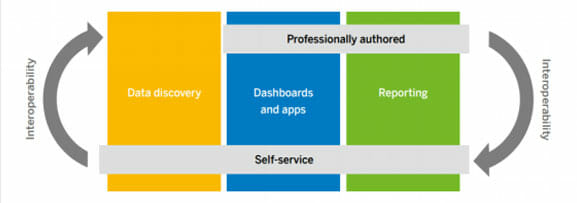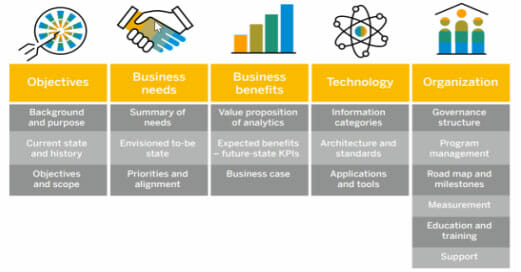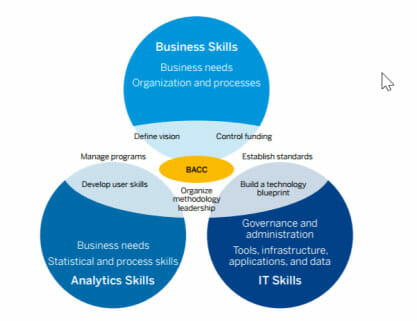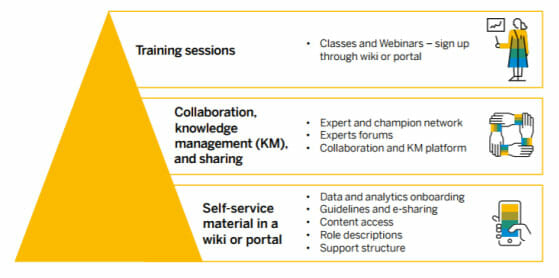Today’s digital world and fast paced business environment demands pervasive, timely analytics. Organizations must deliver speed, agility and ease of use for data access and analytics. In response, business intelligence (BI) and analytics teams are shifting to a more agile, self-service model that enables greater user access to data and the ability to create and perform individualized reports and analytics.
Changing Roles and Models
As self-service analytics have become the norm, Information Technology (IT) is spending more time managing data vs. developing analytics. Development activities are focused on analytics that require more skills than users generally have. A new development model is emerging where users develop their own visualizations and if they need to be placed into a production rotation, IT does so for broader user. This co-development model is addressing generally strained resources to meet explosive analytic demands.
The figure below illustrates this development model

Figure 1: Self-Service Analytics Development Model
Self Service Strategy
Successful self-service doesn’t just happen; it requires a best-practices framework. It needs a sub- strategy as part of the organization’s overall analytics strategy that is able to use the same best practices framework, with a specific focus on key self-service aspects like data, tools, and education and training that are people focused. The SAP analytics strategy framework below covers five key best practice pillars.

Figure 2: Analytics Strategy Framework
Business Analytics Competency Center
Once you’ve defined your strategy, you must operationalize it. A business analytics competency center (BACC) or center or excellence (BACOE) is how most organizations define and implement an analytics strategy, align analytics initiatives with corporate strategic goals, and ensure return on investment.
The BACC is a partnership between the business users and IT, often working virtually, combining business, IT and analytics skills of business analysts, developers, and the data management team. IT supports self-service in provisioning trusted data, selecting tools, user training and education, expert development services, and best practices.

Figure 3: Business Analytics Competency Center Partnership
Data Management Foundation
Successful self-service requires data access, trust and understandability. As self-service grows, it adds new requirements to your data strategy and involves more data, especially third party and external data. As self-service takes off and users become more engaged in data preparation and defining new metrics, you’ll need to revisit your data strategy specifically for self-service. Some areas to consider are:
- Which data sets need to be promoted to enterprise sources, and how will that happen?
- Where does cleaning and transforming take place?
- Where do calculations take place?
- Is there a feedback process in place for dealing with errors and inconsistencies found in the data?
- How will you move the data to avoid creating (more) silos?
- How do you define user permissions for sensitive or regional data sets?
- How will you share common reference data and enrichment sources?
- How will you manage third-party data sets such as demographic data?
Your self-service data strategy needs to be part of your information governance team’s agenda to ensure data confidence and usability.
Challenges – Enablement and Ongoing Communication
The benefits of self-service are significant – increased user satisfaction and better IT resource allocation — but is not without challenges. Data access and security, data quality and understandability, culture and change management, and training, education, and support are challenges that must be addressed. Culture and change management and training and education are key to self-service user adoption. Formal onboarding, training, mentoring and ongoing communication through communities of interest or practice, build user confidence and skills. The figure below shows a training approach that leverages both formal and informal training.

Figure 4: Self-Service Training Approach Best Practices
New Self Service Resources
As self-service operations increase, IT must examine developing unique self-service resources and capabilities. Following is a short list of competencies every organization should consider, drawn from the SAP Self Service Analytics Best Practices e-guide :
- Innovation services, including design thinking, digital disruption, live enterprise, etc.
- Training and support, for knowledge transfer best practices, some of which can be automated as self-service expands
- Data Bureau, which should serve as a central storage facility for internal, external, structured, unstructured, and curated enterprise data
- Tools Bureau, which should provide tools that satisfy a breadth of use cases for a wide variety of users
- Sandbox / Lab Environments, which provide a governed playground of data and technology that gives business the chance to ask and answer new questions in new ways and test new tools
- Marketing and Community building, with communities of interest or practice where users learn from each other
- Analytics Knowledge Management where users can pose questions and comment on tips, issues, etc. across BI tools in a knowledge management repository
- Analytics on Analytics which can review adoption, license usage, and potential impact of increased and new uses for productive systems
Conclusion
In summary, self-service analytics are here to stay. Working together within a business analytics competency center with targeted focus on self-services, IT and the business can ensure optimal sped, flexibility and agility.







